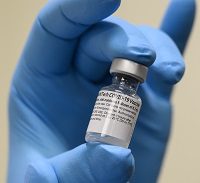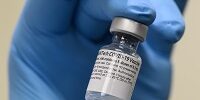THE EMERGING ROLE OF LABORATORY PROFESSIONALS IN THE COVID-19 RESPONSE
Shawn Luby, MS, MLS(ASCP)CM
 |
| Photo credit: Lisa Ferdinando, U.S. Department of Defense |
So, what can you tell me about these T-cells I keep hearing about?”
This was a question I honestly never imagined I would be answering during a weekly video call with my family amidst an ongoing global pandemic. Luckily for my family members, I was knee deep in virtually teaching our MLS students about the intersection between the innate and adaptive immune response, and I felt confident that I could give adequate justice to the mighty T-cell in 30 seconds or less.
In my mind I eloquently responded to my family (full of musicians) with something along the lines of, “T cells are like a musical bridge, helping to connect the different parts of our immune response.” In reality, I panicked a bit, tried explaining Cd4+ vs Cd8+ T cells, stumbled through MHC class I and II (why did I bring this up?), and unceremoniously ended with, “You are all more than welcome to check out my video lectures if you’d like,” to which my family chuckled and politely declined.
ASCLS recently joined the COVID-19 Vaccine Education and Equity Project. Find resources to advocate for the vaccine at covidvaccineproject.org/resources.
In reality, the experience of laboratory professionals serving informally as health educators is nothing new, as my inbox full of lab results sent along from friends, family members, and family member’s pets can attest. What is new, of course, is the urgency in the general public’s desire for a broader understanding of molecular testing, virology, and the immune response.
Navigating this sudden interest in our daily professional lives has been interesting to say the least, however, the educational service and public health advocacy that we as laboratory scientists will provide during the COVID-19 pandemic is just beginning.
As the conversation shifts from testing to vaccination, we will once again be called upon to support and guide our communities—this time through a global vaccination campaign. Certainly, the development of multiple effective vaccines is something to celebrate.1 Importantly however, if we look at previous vaccination strategies, it is clear that the public’s “buy-in” or demand for a vaccine is a most crucial element in any successful vaccination program.2
As such, implementation will require clear communications, and as valued members of the medical community, we should prepare now to engage in these efforts. To put it simply, the time for the medical laboratory community to collectively embrace and harness our strength as public health advocates has arrived, so let’s get ready.
Addressing Vaccine Hesitancy
Established in 2012, the international SAGE Working Group on Vaccine Hesitancy identifies three factors—known as the 3Cs—that impact an individual’s hesitancy in seeking vaccination: confidence, complacency, and convenience.3
Further, they denote specific categories that influence the 3Cs: contextual influence (geographical, political), individual/group influences (perception and social influence), and vaccine/vaccination-specific influences (cost, ease of access).3 Importantly they noted, while communication was not a specific categorical factor like the 3Cs, the lack of adequate communication from any vaccination program negatively influences the community’s “buy-in,” and contributes to overall hesitancy. The working group notes that when hesitancy is identified, it must be addressed, with the goal being to clearly highlight the value of the vaccine to the community through education.3
Globally, there are already widespread reports of apprehension and hesitancy with regard to COVID-19 vaccination.4 There are questions from the public about the unprecedented speed of development that will need to be addressed.5 There are also clear concerns about the continued underrepresentation of people of color in COVID-19 vaccine clinical trials, a likely consequence of a system still struggling to acknowledge and ameliorate the deep seeded and omni-present influences of racism in our medical instituions.6,7
Finally, there will be questions regarding vaccine technologies, transportation and storage, and the availability and administration of the vaccine itself. The challenge to all of us will be to respond with understanding, patience, and a good amount of clear and accessible scientific information.
How to Be a Vaccine Advocate
The first step is to stay updated on the science behind the vaccine. The New England Journal of Medicine has made all publications related to COVID-19 available to the public for free at www.nejm.org/coronavirus. The World Health Organization is posting regular updates monitoring the progression of COVID-19 vaccine candidates, along with an impressive Q&A section addressing vaccine development, safety, and administration.8 Additionally, your workplace or local health departments may develop COVID-19 vaccine educational materials, which can be shared with members of your community.
The next step in the process is to get involved. Consider proactively reaching out to family and friends to see if they have any questions about COVID-19 vaccination. Research suggests that a simple conversation with a trusted health provider has a strong influence on vaccine compliancy, and certainly your conversations will provide opportunities for your community members to gain confidence in their understanding of the vaccine.2
If that goes well, consider preparing a short presentation covering vaccine topics like mRNA, spike proteins and IgM vs IgG, and then invite your family and friends to join you online for a COVID-19 education session. On an institutional level, approach (and encourage) laboratory administrators to support the development of lab-led public health messaging regarding COVID-19 testing, vaccination strategies, and immune responses.
Finally, be prepared to continue these conversations for many months to come. Some estimates suggest that it will take until 2023 to achieve global coverage, and while we wait for vaccine production and delivery, we will certainly continue to see an avalanche of COVID-19 information and misinformation on social media.9 In this environment, we will be looked to for our expertise, and it will be needed for the duration.
Importantly, take the time to celebrate your successes and share your strategies. After all, while the stakes have never been so high, our visibility as medical laboratory professionals has never been higher, and it will take all of us, working together, to succeed.
References
- Covid vaccine update: Tracking progress against coronavirus – Washington Post [Internet]. [cited 2020 Nov 23]; Available from: https://www.washingtonpost.com/graphics/2020/health/covid-vaccine-update-coronavirus/
- Weintraub RL, Subramanian L, Karlage A, Ahmad I, Rosenberg J. COVID-19 Vaccine To Vaccination: Why Leaders Must Invest In Delivery Strategies Now. Health Aff 2020;10.1377/ hlthaff.
- MacDonald NE, SAGE Working Group on Vaccine Hesitancy. Vaccine hesitancy: Definition, scope and determinants. Vaccine 2015;33(34):4161–4164.
- We’re running out of time to tackle COVID-19 vaccine hesitancy. Pharm J 2020.
- Heaton PM. The Covid-19 Vaccine-Development Multiverse. N Engl J Med 2020;383(20):1986–1988.
- Vaccine trials need Black volunteers – The Washington Post [Internet]. [cited 2020 Nov 23]; Available from: https://www.washingtonpost.com/business/2020/10/27/covid-vaccine-trials-need-blacks/
- Mensah GA. Black and minority health 2019: more progress is needed. J Am Coll Cardiol 2019;74(9):1264–1268.
- The push for a COVID-19 vaccine [Internet]. [cited 2020 Nov 30]; Available from: https://www.who.int/emergencies/diseases/novel-coronavirus-2019/covid-19-vaccines
- COVID-19 Vaccine Predictions: Using Mathematical Modelling and Expert Opinions to Estimate Timelines and Probabilities of Success of COVID-19 Vaccines | Center For Global Development [Internet]. [cited 2020 Nov 24]; Available from: https://www.cgdev.org/publication/covid-19-vaccine-predictions
Shawn Luby is Assistant Professor in the Division of Clinical Laboratory Sciences at the University of North Carolina-Chapel Hill.
